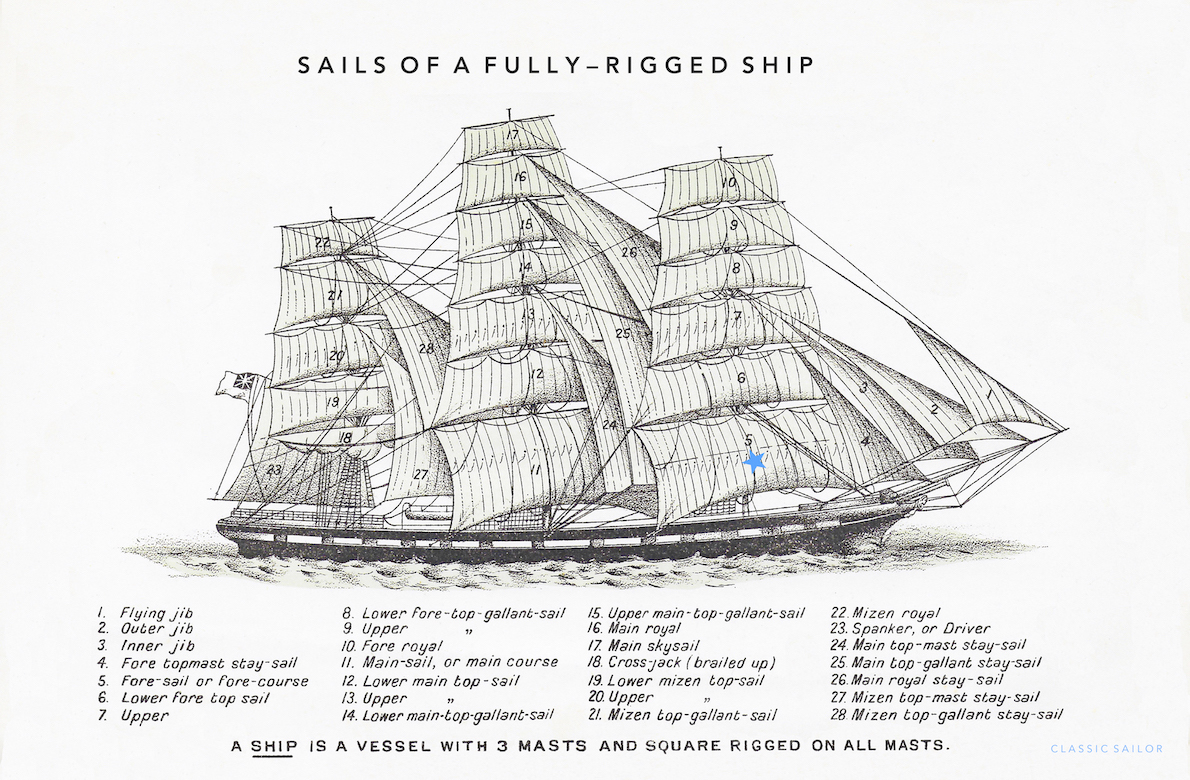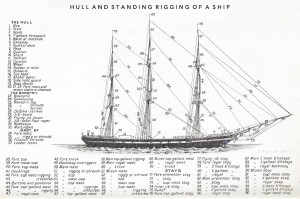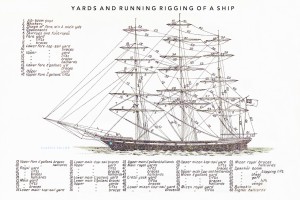The full-rigged or fully-rigged ship was an excellent example of early industrial standardisation, writes Dan Houston. With the trade of the sailor being international there was a need to rig ships in the same way, so that when new crew came aboard they needed little time to familiarise themselves; all the rigging, sheets, buntlines, haliards, lifts and braces would be in the same place.
This meant that on a foul night with the heaving deck as black as pitch you could put your hand on the right coil of rope on the Fife rail around the base of mast, or one of the pin rails against the bulwarks on either side of each mast, and by counting from fore, or aft, you would know it was the right line. On some ships manilla would be used for braces and sheets and hemp for haliards so that you could also tell by the feel of the cordage in the days of natural fibre.
The natural fibres used in the early days of sail were almost always made of hemp (flax) in Europe, with manilla being introduced in the early 19th century according to the rope expert Des Pawson. “Stuff like sisal would be much later – more like the middle of the 20th century,” he added when I told him a ship I sailed used sisal for buntlines – its coarse and hairy feel being instantly recognisable when you needed to take the drive out of a square sail prior to crew going aloft to stow it along the yardarm. On that ship we also used jute for the ratlines. Hemp was also used for for standing rigging and it would be tarred.
Learning the ropes is an expression still used today and has passed into everyday language. For the apprentice seaman he learned as he went and he was considered able-bodied when he could demonstrate that he knew the ropes (as well as how to use them and look after them).
There were two ways to get high on a sailing ship in the days of sail… One was persuading someone to give you their rum ration as well as your own and the other was to become an upper yardsman, demonstrating, through strength and agility that you could work the topgallants, royals and skyscraper or moonraker sails as they were often known. Up there on your own, or maybe with one other for company you could feel like you were flying as the ship’s mast described a massive arc so far above the rolling deck below. Sails are furled and secured by working from the outer edge of the weather end of the yard – the opposite being the case when setting them.
Other types of traditional sailing vessels included the barque, barquentine, brig, schooner and ketch as shown below.

Types of sailing vessel, some drawings show jibs sheeted inside the inner jib or staysail; either a mistake or the artist’s attempt to show sailing wing-on-wing
In these days of horizon-to-horizon bermuda yachts, not every sailor feels the need to recognise or have any knowledge of the types of traditional vessel let alone the names of the masts, yards, sails, &c., carried by sailing ships. But why not put aside the bliss of ignorance for the permanence of learning and familiarise yourself with some ship history – these vessels do still appear on the horizon from time to time.
The above illustrations give such information in graphic detail – below are some definitions of each vessel type:
A Ship: a vessel with three masts, and square rigged on all three.
Barque or Bark: a three-masted vessel, square rigged on the fore and main, and fore and aft rigged on the mizen mast.
Barquentine: a three-masted vessel, square rigged on the foremast and fore and aft rigged on the main and mizen masts.
Brig: a two-masted vessel, square rigged on both masts, and with a boom mainsail.
Brigantine: a two-masted vessel, square rigged on the foremast and fore and aft rigged on the mainmast.
Schooner: a vessel with two masts, fore and aft rigged on both. They are also built carrying four or five masts or even seven in the case of the Thomas W Lawson.
Topsail Schooner: the same as a schooner, but carrying a square topsail (most usually split tops’ls) and topgallant on her foremast.
Cutter: a vessel with one mast, and fore and aft rigged, usually referred to as a gaff cutter.
Yawl: the same as a cutter, but carrying a mizen mast stepped well aft. (Aft of its steering gear/rudder head is the usual rule.)
Ketch: similar to a yawl with the difference that the mizen mast is stepped further forward and well before the rudder-head.





[…] The Fully-Rigged Ship from Classic Sailor Magazine […]